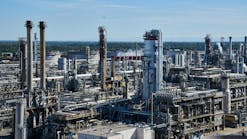In line with the lowest price volatility in years and stable crude oil prices, cash flow from operations for major energy companies has flattened. Data compiled from quarterly reports suggest that, for the year ending Mar. 31, cash from operations for 127 major oil and gas companies totaled $568 billion, and major uses of cash totaled $677 billion, generating a gap of almost $110 billion, according to a recent study by the US Energy Information Administration.
The study noted that to fill the shortfall and increase the overall cash balance, major energy companies have increased net debt by $106 billion and gained proceeds of $76 billion from asset sales.
EIA also noted that, during the past 3 years, the gap between cash from operations and major uses of cash has widened in recent years from a low of $18 billion in 2010 to $100-120 billion.
According to information revealed by companies' cash flow statements, average cash from operations from 2012 through this year's first quarter increased $59 billion, or 12%, compared with its 2010-11 average. At the same time, major uses of cash increased from an average of $548 billion in 2010-11 to $684 billion in the 2012-14 period.
"While capital expenditures, typically the largest use of cash, accounted for most of the increase, cash spent on share repurchases increased $39 billion on average. In fact, net share repurchases was a source of cash for the 2010-11 average, changing to a net use of cash in mid-2011," EIA said.
To meet spending with relatively flat growth in cash from operations, companies increased their borrowing. When comparing the major sources of cash for the first quarter only, the net increase in debt has made up at least 20% of cash since 2012.
An increase in debt, however, is not necessarily a negative indicator.
"Production in North America, where many of the reporting companies have major operations, has increased dramatically in recent years. Using debt to fuel growth is a typical strategy, particularly among smaller producers. The increased debt load is anticipated to be met with increased production, generating more revenue to service future debt payments," EIA said.

